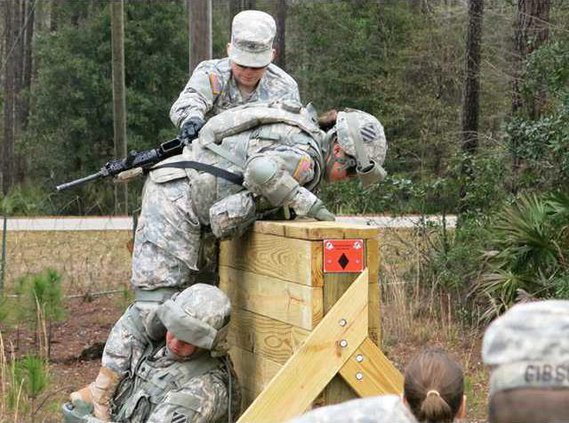Fort Stewart soldiers who volunteered to be part of the Army’s Physical Demands Study have completed five weeks of training and now are being evaluated.
On Wednesday, media outlets from as far away as New York and Washington, D.C., were invited to witness the second day of the evaluation conducted by the U.S. Army Research Institute of Environmental Medicine.
According to Jack Myers and Dr. Edward Zambraski, the study is part of the Army’s Soldier 2020: Standard for the Army Professional approach. Although information from the study may be used by the Army to develop the Department of Defense’s new gender-integration policy, they said the study was something the Army has been working on for years.
“Soldier 2020 is the Army’s comprehensive approach for putting the right soldier in the right job,” Myers said. “We want to know what it takes to be an infantryman, mortar man, scout, (tanker), artilleryman and combat engineer. ... Gender integration is separate from Soldier 2020.”
He said scientific data from the physical-demands study will determine the physical requirements necessary to perform 31 combat-arms tasks. The Training and Doctrine Command, which oversees the study, was told by combat-arms branches that these tasks are required. Zambraski said that as the volunteer soldiers perform each task, they wear instruments that measure their metabolism, heart rate and breathing.
The evaluation will test their physical strength, endurance and coordination, he said. He emphasized the evaluation does not determine whether males can do the tasks better than females. The evaluation will only determine if the subject volunteer can perform the task to a minimum standard.
Zambraski said his team was given three years to complete the study. At the end of the study, he said they will have developed a physical-ability test that will measure a perspective recruit’s ability to perform the physical demands of a particular military-occupational specialty. He told the Courier that the Army Recruiting Command has been closely involved with the program from the beginning. Recruiters may one day administer the physical-requirements test along with the Armed Services Vocational Aptitude Battery, he said. He added that all recruits would be required to take both tests, regardless which occupational specialty they wanted to join.
“The greatest medical problems in the Army are muscular-skeletal injuries,” Zambraski said. “One goal of this study is to reduce those kinds of injuries.”
He explained those injuries mostly tend to be injuries to the back and lower extremities, like the knees and ankles. He didn’t have any statistics but said the soldiers in combat arms military-occupational specialties, combat medics and light-wheeled vehicle mechanics tend to have the most injuries. The physical-demands study also would help the Army develop the Army Physical Fitness Readiness Test to better prepare soldiers’ muscles to deal with the weight and stress, and change tasks conditions to reduce the chance of injuries.
Lt. Col. Mark Olsen, commander of the 1st Battalion, 30th Infantry Regiment, which conducted the physical-demands-study training, said his unit created three gender-integrated platoons then trained the volunteers to a level where all could complete the required tasks to standard.
“We didn’t choose them,” said Col. Scott Jackson, commander of 2nd Armored Brigade Combat Team. “(These female soldiers) volunteered. We started with 60. There are 58 now. The two not here are pregnant.”
The tasks being evaluated Wednesday included movement under fire, climbing over an 8 1/2-foot wall and carrying two 65-pound ammo cans about 15 meters. Sgt. Robon McKay, an infantry fire-team leader with 13 years in the Army and six deployments under his belt, said he hopes the study might prove some female soldiers are capable of doing infantry tasks. As he talked with media, a female soldier approached a wooden wall, stepped in the hands of male soldier while another male soldier helped her onto the top of the wall. McKay said he and the members of his fire team had helped the female volunteers learn how to do tasks they couldn’t do when they started the training.
Capt. Nartrish Lance spoke to media, still breathing heavily from just carried several ammo cans. The signal officer with 21 years in service said she started her career as an enlisted soldier working in administration. She said if she was a younger soldier, she might consider the infantry. According to a March 6 report by military.com, Lance is one of 7.5 percent of female soldiers interested in combat jobs. The report noted that only about 20 percent of its 1.1 million jobs are direct-combat related.
As the day’s evaluation neared a close, Maj. Gen. Mike Murray, 3rd Infantry Division commander, told media that when he first observed the gender-integrated platoons five weeks ago, they were like students at a high school dance, with girls lined up on one side of the gym and boys on the other. He was proud to say the soldiers appear to be working together as a team.
“In my 32 years in the Army as an infantry officer, there’s one thing I’ve always found to be consistent,” Murray said. “For every task, the Army will develop a condition and standard.”
He said he could not predict the results of the demands study but said he is confident the study will help develop the Army of the future.
Army testing soldiers' meddle
Physical Demand Study in evalutations


Sign up for our e-newsletters